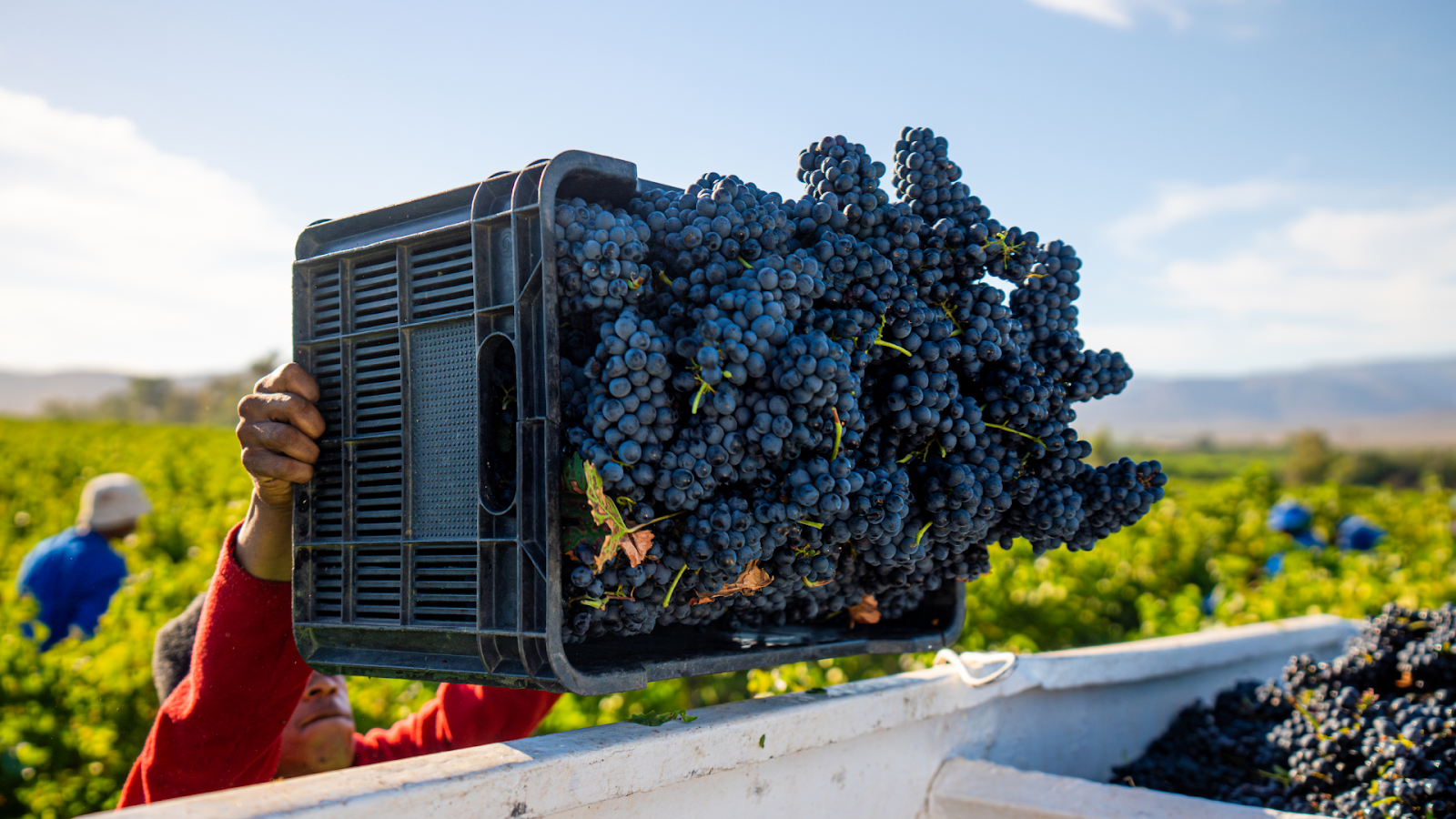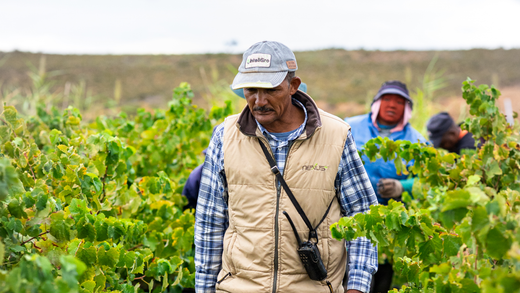In 1659, Jan van Riebeeck wrote in his diary: “Today, praise be to God, wine was made for the first time from Cape grapes…” It was a landmark moment in the history of South African wine. But there is plenty more to the story, both before and after van Riebeeck enthusiastically recorded the achievement.
Wine connoisseurs flock to South Africa in droves every year to experience our award-winning wines. Yet, to many, it is still a mystery how and when wine reached the shores of our beautiful country – as well as how it managed to flourish in the face of multiple challenges.
In this article, you’ll learn how wine first came to South Africa, who was the real wine mastermind (not Van Riebeeck, as it turns out), and just what makes our wine so special.

In 1659, Jan van Riebeeck wrote in his diary: “Today, praise be to God, wine was made for the first time from Cape grapes…”
How Did Wine Come to South Africa?
South Africa is part of the New World wines, among the likes of Australia, New Zealand and Argentina. We might not share the long wine history as that of France, Italy or Spain, but the South African Wine Harvest Report 2021 indicates that we are currently the ninth largest wine producing country in the world.
To fully appreciate the history of South African wine, we should begin by tracking how vines first travelled across the globe to the fairest Cape.
The first written history tells us of Noah (yes, of Noah’s ark!) planting a vineyard. But evidence suggests that wine originated in Persia at least 8000 years ago. From Persia, the Phoenicians transported vines to Egypt and Greece, then further along the southern tip of Europe, until it finally reached Rome. As the Romans conquered the then-known world, they aided in the worldwide adoption of wine.
After the collapse of the Roman Empire, wine endured the Dark Ages, as well as the subsequent wars and plagues. This was in large part due to the Catholics, who needed wine as much for their Holy Sacrament as for its medicinal qualities. Wine was also an essential item aboard trade ships, not just as a temporary relief against scurvy, but as a substitute when water was hard to come by.
It was only in 1652, when the Dutch East India Company decided to establish a settlement in the then-called Cape of Storms to provide supplies to trading ships circumnavigating Cape Point, that wine made its way to South Africa.

Wine was an essential item aboard trade ships, often a substitute when water was hard to come by.
When Was the First Wine Produced in South Africa?
Here’s where Jan van Riebeeck, an official of the Dutch East India Company, makes his entrance. He was elected to set up the trading post in Cape Town. He was later joined by European settlers, called the Free Burghers, who chose to relocate to the Cape of Good Hope. The burghers were allowed to farm and trade with passing ships, provided they first supply the Company ships.
As the need for wine arose, van Riebeeck believed that the terrain, combined with the Mediterranean climate, made the south-western tip of the continent favourable to viticulture. He imported rootstocks from France and Spain, then planted them in the Company Gardens.
With a limited understanding of wine, van Riebeeck only initiated the idea of producing wine in South Africa. It was, in fact, his successor, Simon van der Stel, who spearheaded the immediate growth of the industry after he took over as Governor of the Cape in 1667.
Van der Stel was not only well educated, but also an avid hunter who was knowledgeable about agricultural matters. He set about aggressively expanding upon the production of wine by planting thousands of vines. First, he focused on the area around Liesbeeck River, before moving further inland to establish Stellenbosch and Franschhoek. Upon his retirement, he established what became known as Constantia.
Celebrated Cape Wine Master Junel van der Merwe – of Alvi’s Drift winery in the Breede River Valley – explains that van der Stel was instrumental in turning the trade around. During his reign, he also introduced Pontac and Muscat de Frontignan (today known as Muscat à Petits Grains) grape variets to the Cape.
“He taught them about cleanliness in the cellars and fining of wine. He also told them to pick grapes at a later stage, thereby allowing more sugar to develop. This improved the quality of the wine and gave it more body,” explains Junel.
“On the skin of a grape, there is a waxy layer referred to as bloom, which contains all the wild yeasts and bacteria. Back then, that was all the winemakers had to make wine with. Once the skin of a grape berry burst open, these yeasts and bacteria interacted with the sugar, and that triggered the fermentation, which is why most antiquity wines were sweet or semi-sweet – as wild yeast could often not ferment completely dry.”
Akin to the birth of the American wine industry, it was the arrival of French Huguenot settlers that further catalysed the wave of wine production in the Cape. These winemaking families settled in an area just outside of Stellenbosch, later called Franschhoek, and began planting vines.
After van der Stel retired, his son, Willem Adrian, along with a small group of company officials, secured the monopoly over most of the trade in the Cape, which made life uncomfortable for the free burghers. Eventually Adam Tas led a revolt by convincing some of the burghers to sign a petition against van der Stel’s illicit dealings. The petition would later be acted upon by representatives in the Netherlands. They dismissed van der Stel and forbade Company officials from owning land at the Cape.
These series of events set in motion a progressive viticultural journey that would make the Western Cape one of the finest winegrowing regions in the world. Stellenbosch, along with the wine-producing towns of Franschhoek, Paarl and Wellington, would eventually become the Cape Winelands.

As the years rolled on, so the wine industry flourished and expanded across the Western Cape. Today, the area comprises five wine regions, namely the Coastal, the Breede River Valley, Klein Karoo, Olifants River, and Cape South Coast (the most recent, formally added in 2012) regions.
Undoubtedly one of the most fascinating, varied (and underrated) region is the Breede River Valley, which is also the largest wine producing region in South Africa.
While the first settlers arrived here in the 1700s, they predominantly farmed with livestock and fruits. Much later, in the mid-nineteenth century, German settlers were the first ones to plant vines in the region. Little did they know that the region would eventually produce nearly 40 percent of all wine producing vines in South Africa, including varieties such as Chardonnay, Sauvignon Blanc, Cabernet Sauvignon, Pinotage, Shiraz and Chenin Blanc.
In the 1930s, driven by a lifelong dream to produce wines on his family’s farm, Albertus Viljoen “Alvi” van der Merwe oversaw the construction of a low water bridge across the Breede River, which linked the two sides of the family farm. This drift offered them ease of access across the river and is still in use today. Alvi’s Drift wine farm now produces some of the finest, award-winning South African wine.
Due to a tragically low rainfall, the area experiences sustained droughts (in fact, the entire Western Cape winemaking region has experienced some of the most severe droughts ever over the last nine years). In true South African tradition, this was never a justifiable excuse to let a land lie fallow. Clever farming and water-saving initiatives have gone a long way towards ensuring a steady production during the toughest conditions, while delivering some of the most spectacular wines.
With a terroir that is exceptionally diverse with some of the country’s best wine-growing soils and conditions, you can expect to find a surprise varietal popping up at every winery. Between wine tastings, bistro lunches and taking in the breath-taking scenery, take the time to seek out notable wine brands such as Nuy Cellar, Cilmor Sauvignon Blanc, or Alvi’s Drift’s award-winning Signature Viognier.
What Makes South African Wine So Special?
South African wine farmers have repeatedly shown that they are able to adapt to adversity in pursuit of wine excellence. Dubbed the new kids on the block, South Africa has become known as the country with a wine for any occasion.
What truly sets our country and its wine apart, however, is the vibrant culture that visitors encounter when they stop off for their first wine tasting in the Cape.
All regions play host to bespoke events, including celebrations, special launches or weddings, big and small. No matter the occasion, there will be a venue, winery and perfect wine in every region to keep guests satisfied.
According to Conrad Louw, Wine Master and wine ambassador extraordinaire, the different regions complement one another and celebrate diversity by offering visitors unique experiences, no matter which region they visit first.
“Over the past centuries, South Africa’s wine-growing regions have constantly produced first-class quality wines, notably Stellenbosch and Constantia. The wines were globally regarded as excellent yet well-priced,” explains Louw. “Nonetheless, in recent decades, certain areas have upped their game and are now producing premium wines. The Swartland, previously known as the ‘breadbasket’ of South Africa, progressed from a co-op wine district to an area that produces truly iconic wines. Another region which predominantly produced wine for brandy distillation, is the Breede River Valley, where especially old vines are nowadays being used to produce stellar wines, particularly those made from SA’s workhorse, Chenin Blanc.”
Taste Some of the Best of the Breede River Valley
Nothing better encapsulates the toil, determination and winemaking prowess evidenced across the regions than the achievements of Alvi’s Drift. With awards across their ranges, their family-owned vineyard is one outstanding example of just how far the South African wine industry has come in a relatively short space of time.
To learn more about our wines and find your favourite, visit our online store.







